
Beroe Survey: Digital Innovation Driven by Cost Efficiency

Data Collection and Compilation by Mirza Zack

We find ourselves at a pivotal moment in the evolution of procurement, where digital solutions are transforming the function’s landscape at an unprecedented pace. Navigating this dynamic terrain effectively requires not only an understanding of the technologies themselves but also insight into how they are being received by the professionals they are designed to serve.
This is why Beroe conducted a survey on the digital procurement landscape among member of the Beroe LiVE community, seeking to gain valuable insights into the awareness, perceptions, and readiness of the procurement community regarding the latest innovations in the field.
Procurement professionals from over 140 companies across the globe took part in the Beroe survey. The survey results offer a comprehensive snapshot of the perceptions, challenges, and aspirations with regards to digital innovation.
The breakdown of respondents' job profiles in the digital procurement survey illustrates a diverse mix of roles within the procurement landscape. Seven percent hold the position of Chief Procurement Officer (CPO) or Head of Procurement, showcasing strategic leadership involvement.
Directors, comprising 16%, contribute to the upper echelons of management, while 1% hold the position of Vice President. The majority, at 40%, falls under the category of Managers/Senior Managers, representing a significant presence in mid-management roles crucial for operational execution. The remaining 36%, classified as "Others," likely includes various roles not explicitly listed, adding an element of diversity to the respondent pool.
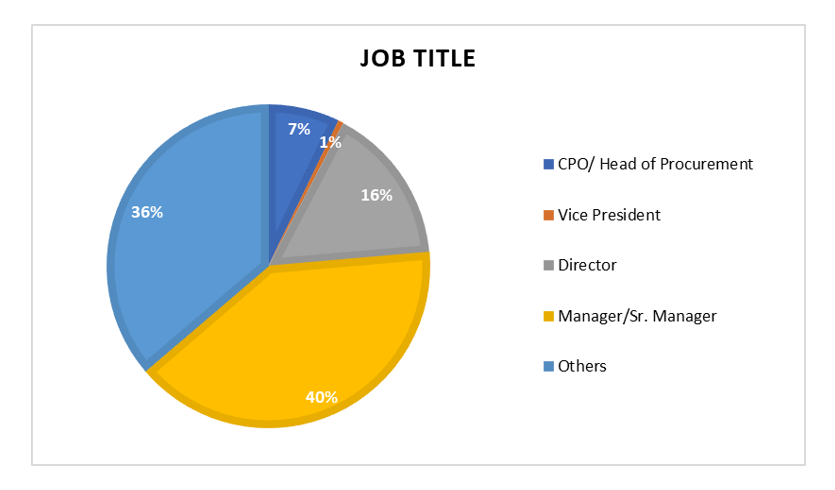
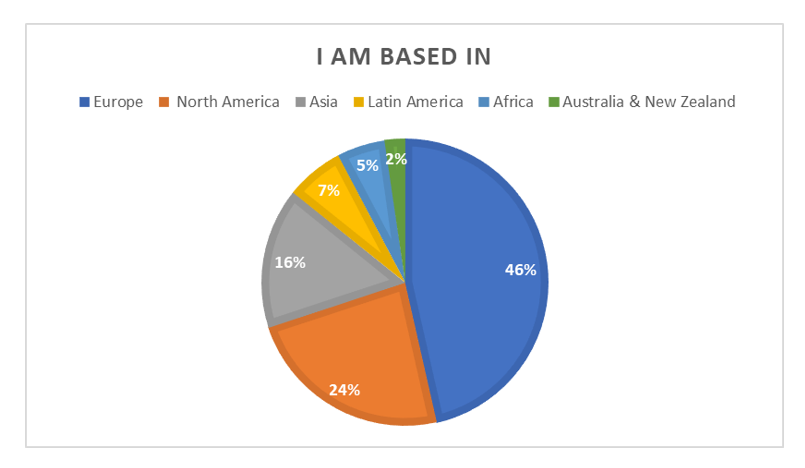
Awareness of Digital Procurement Technologies
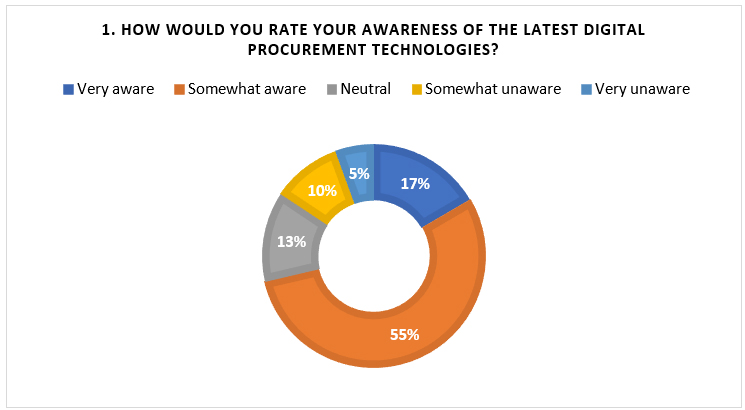
A majority of respondents (55%) report being somewhat aware, showcasing a moderate level of familiarity. Notably, 17% claim to be very aware, suggesting a well-informed segment, while 13% maintain a neutral stance. Those somewhat unaware and very unaware constitute 10% and 5%, respectively.
These findings highlight a varied landscape of awareness within the surveyed group, with a notable portion expressing a substantial understanding of digital procurement technologies.
Learn about new procurement technologies
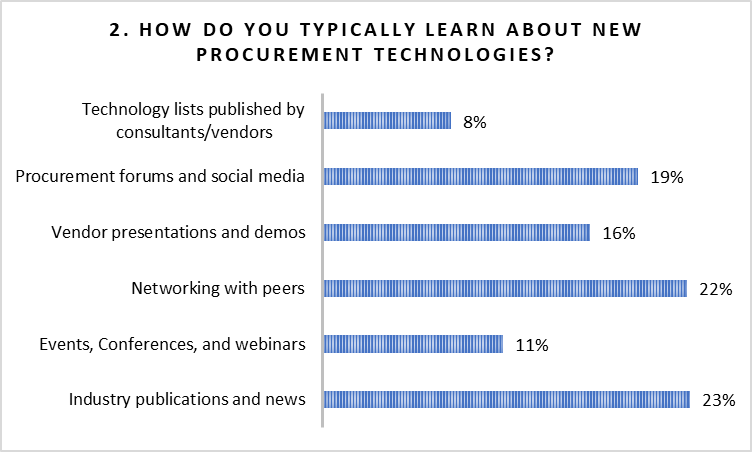
The survey reveals diverse channels through which respondents learn about new procurement technologies. The majority (23%) rely on industry publications and news, indicating a preference for staying informed through established sources.
Networking with peers is a popular method, chosen by 22% of respondents, emphasizing the value of interpersonal connections in staying updated. Vendor presentations and demos play a significant role for 16% of respondents, suggesting that direct engagement with technology providers is a notable source of information.
Additionally, procurement forums and social media are relevant channels for 19% of respondents, reflecting the impact of online platforms in technology awareness. While technology lists from consultants/vendors are less commonly used (8%), they still contribute to the overall mix of information sources.
Overall, these findings highlight a diverse set of preferred channels for staying abreast of new developments in procurement technologies.
Select comments from respondents:
-
“I most often learn about new technologies from conferences and suppliers”.
-
“We have someone internally who leads and summarises for the senior management team”.
-
“I work at a large global company with procurement org to match. I only learn of new procurement technologies when they are implemented by my company as I do not have the flexibility to use new technology unless it is embraced and approved by my company”.
-
“Research, ProcureTech, DPW, BME, Procurement Leaders, etc”.
-
“It’s a never ending changing and growing landscape so when thinking about future strategy or new tools we need to spend a lot of time in multiple areas understanding what would be the best fit. Once chosen then I tend to drop out of most of these so it's all about my needs at the time”.
Perception of Digital Innovation
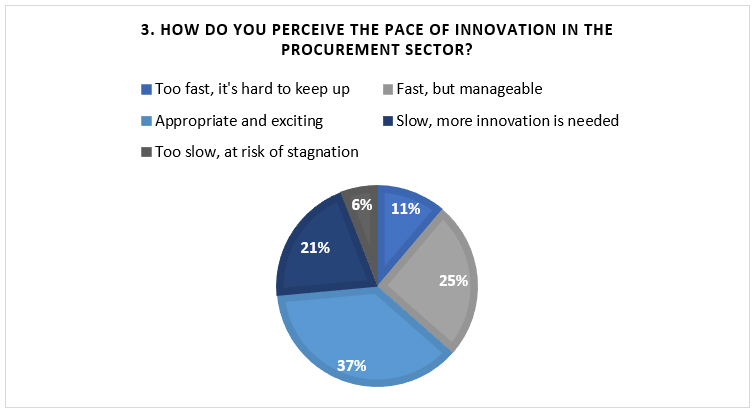
Respondents' perceptions of the pace of innovation in the procurement landscape vary, with the largest segment (37%) finding it appropriate and exciting. This positive sentiment suggests a general openness and enthusiasm toward ongoing advancements.
A quarter of respondents (25%) consider it fast but manageable, indicating a balance between innovation and operational feasibility. On the other hand, 21% believe that innovation is slow, advocating for more advancements to meet evolving needs in procurement.
A smaller portion (11%) perceives the pace as too fast, posing challenges in keeping up, while only 6% think it is too slow and could lead to stagnation.
The varied perceptions of the pace of innovation in the procurement sector, ranging from those finding it too fast to those considering it too slow, underscore the importance of aligning innovation with the unique needs and capacities of organizations. This diversity emphasizes the need for a strategic and adaptive approach to innovation in procurement, ensuring that advancements effectively enhance efficiency, drive positive change, and address specific challenges faced by organizations.
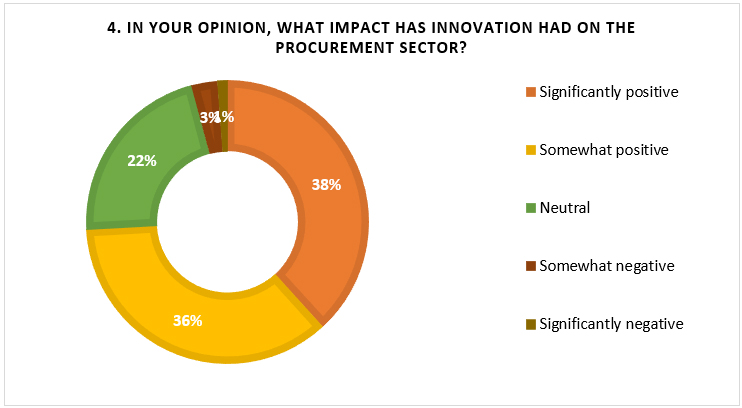
Respondents overwhelmingly perceive the impact of innovation on the procurement sector as positive, with 38% indicating a significantly positive impact and an additional 36% describing it as somewhat positive.
This collective positivity suggests that innovations have been widely embraced and are contributing positively to the procurement landscape. While a notable portion (22%) remains neutral, only a small percentage (3%) sees a somewhat negative impact, and a mere 1% perceives a significantly negative influence.
The predominantly positive outlook underscores the transformative role of innovation in procurement, enhancing efficiency and effectiveness. The solution providers can leverage these favorable sentiments to further promote and integrate innovative solutions that address the evolving needs of procurement processes.
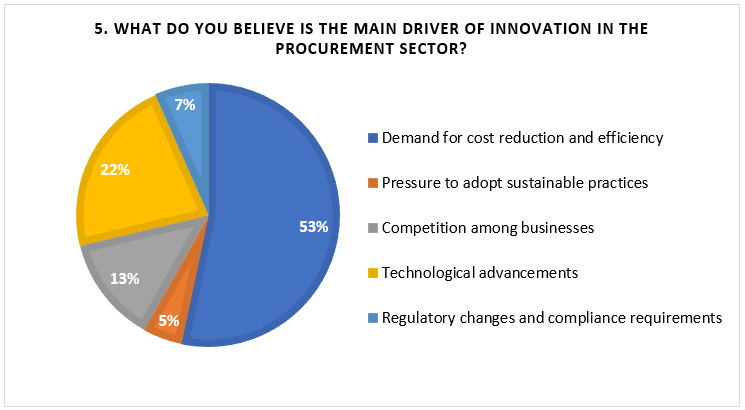
The survey indicates that the majority of respondents (53%) identify the demand for cost reduction and efficiency as the main driver of innovation in the procurement sector. This underscores the practical focus on optimizing processes and resource utilization.
Technological advancements also play a significant role, with 22% attributing innovation to this factor, highlighting the critical link between technology and procurement progress.
Competition among businesses is noted by 13% as a driver, emphasizing the market-driven nature of innovation. A smaller percentage (7%) associates innovation with regulatory changes and compliance requirements, while sustainable practices are identified by 5%.
These findings suggest that, for the majority, the primary impetus for innovation in procurement is the pursuit of cost-effectiveness and efficiency. This underscores the need for procurement solutions to align with these drivers, leveraging technology and fostering competitiveness to drive positive change.
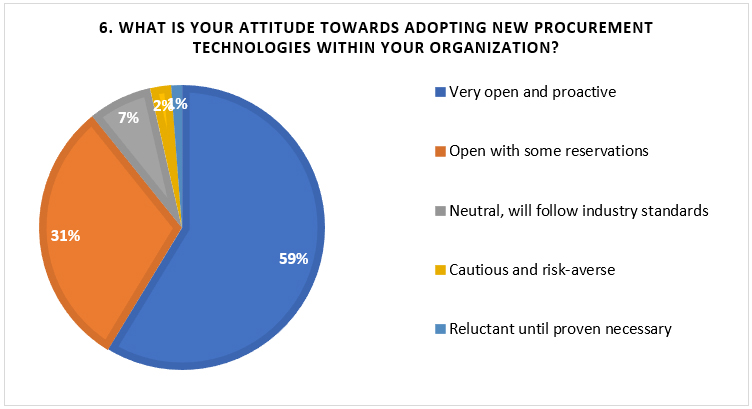
The survey reveals a positive attitude toward adopting new procurement technologies within organizations, with the majority (59%) expressing a very open and proactive stance. This indicates a strong willingness to embrace innovation and leverage technological advancements to enhance procurement processes.
Another significant portion (31%) is open with some reservations, suggesting a cautious yet receptive approach. A smaller percentage (7%) takes a neutral position, indicating a willingness to follow industry standards. The more risk-averse attitudes, including being cautious and risk-averse (2%) or reluctant until proven necessary (1%), represent a minimal segment.
Overall, the prevalent openness signals a favorable climate for the integration of new procurement technologies. The implication is that digital solution providers should capitalize on this positive sentiment to foster a culture of continuous improvement and facilitate the smooth adoption of innovative technologies, ensuring alignment with organizational goals and industry standards.
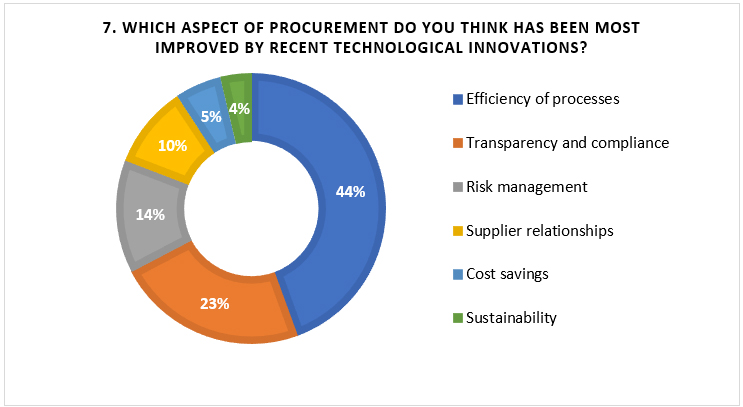
According to the survey, recent technological innovations in the procurement sector are perceived to have most significantly improved the efficiency of processes, as reported by 44% of respondents. This underscores the transformative impact of technology in streamlining and optimizing operational workflows.
Transparency and compliance follow closely, with 23% acknowledging improvements in these critical aspects, emphasizing the role of technology in enhancing accountability and regulatory adherence.
Risk management, supplier relationships, and cost savings are also mentioned, though to a lesser extent. Notably, sustainability is cited by 4% as an area of improvement.
These findings show that technological innovations have brought substantial advancements to core procurement operations, particularly in efficiency and transparency. Organizations should recognize these improvements and strategically leverage technology to further enhance these areas, ensuring they align with broader business objectives and contribute to overall operational excellence in procurement.
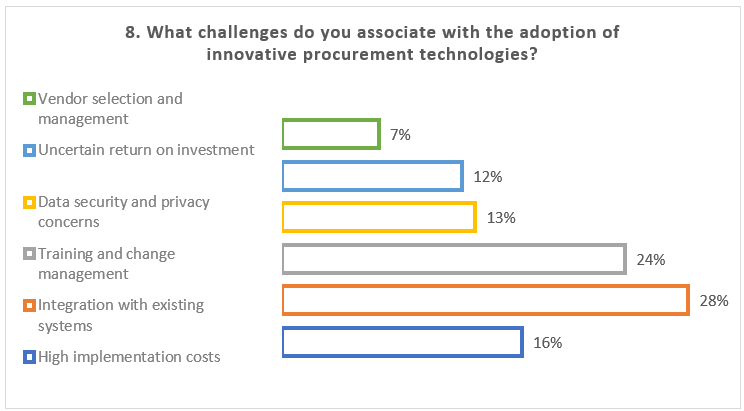
(Multiple selections were allowed)
The survey respondents identify various challenges associated with the adoption of innovative procurement technologies, with 28% expressing concerns about the integration of new technologies with existing systems.
Training and change management pose challenges for 24% of respondents, highlighting the importance of addressing the human factor in technology adoption. Additionally, high implementation costs are a concern for 16% of respondents, while data security and privacy concerns and uncertain return on investment are cited by 13% and 12%, respectively. Vendor selection and management are mentioned by 7%.
The implication is that organizations need to proactively address these challenges to foster successful adoption of innovative procurement technologies, emphasizing the importance of robust integration strategies, comprehensive training programs, and clear communication on return on investment to ensure a smooth transition and maximize the benefits of technology adoption in procurement.
Select comments from respondents:
-
“I may want to implement but the wider teams involved may not want this as they feel it is more work for them, even though once they implement, it would be a significant cost/ time saving”.
-
“The reservations are around the amount of work required and the time it takes to move away from the tech we've embedded globally across more than 20 countries”.
-
“With disruptions caused by multiple factors without any positive control, there is a definite need to be more agile and cost effective in the entire SCM”.
-
“One must always consider the technology can be used against you - so technology must be applied carefully bearing in mind the objective and relative positions on the matrix of the buyer and supplier”.
-
“The real answer is that digital innovation is going fast but it's not interlinked and not connected. Too many innovation are self-stating and not integrated in one platform. What is hard today is the need to access too many different and not integrated platform. Moreover, the IT companies always promise fast integration while is always long, complex and hard. Moreover this is adding cost to suppliers as they have to manage hundreds of different platform of different clients”.
-
“Many procurement technologies are developed and intended to be used for traditional commoditized goods/services. I work in an area of procurement supporting incredibly technical and specialized services, so the vast majority of new technology is difficult to fit into my area”.
-
“While regulatory challenges certainly contribute, legacy systems drive my reservations and whether or not existing innovations can bring them up to speed. Nonetheless, I am still open to new technologies”.
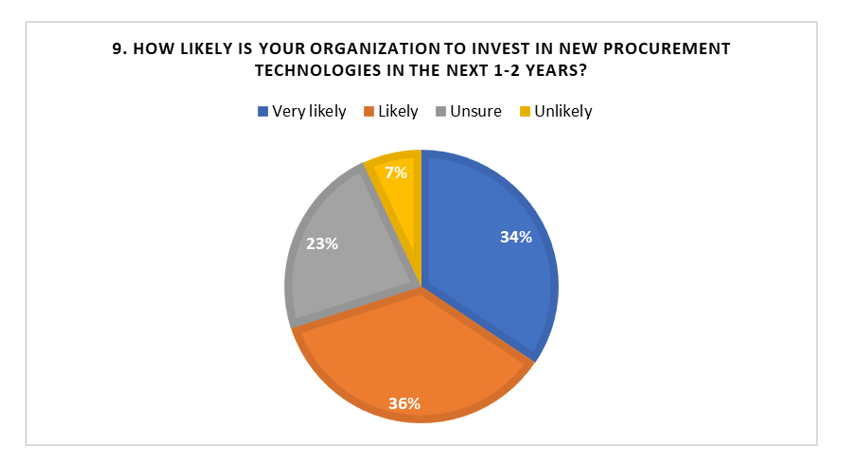
The survey indicates a positive inclination among respondents toward investing in new procurement technologies within the next 1-2 years, with a combined 70% expressing confidence in the likelihood of such investments. Specifically, 34% state that their organizations are very likely to invest, and an additional 36% consider it likely. Only a minority, 7%, deems it unlikely, and notably, no respondents find it very unlikely.
The substantial interest in future investments suggests a prevailing openness to adopting and integrating new technologies in the procurement landscape. This positive outlook bodes well for the continued evolution and enhancement of procurement processes through technological advancements.
Decision Confidence in Solution Selection
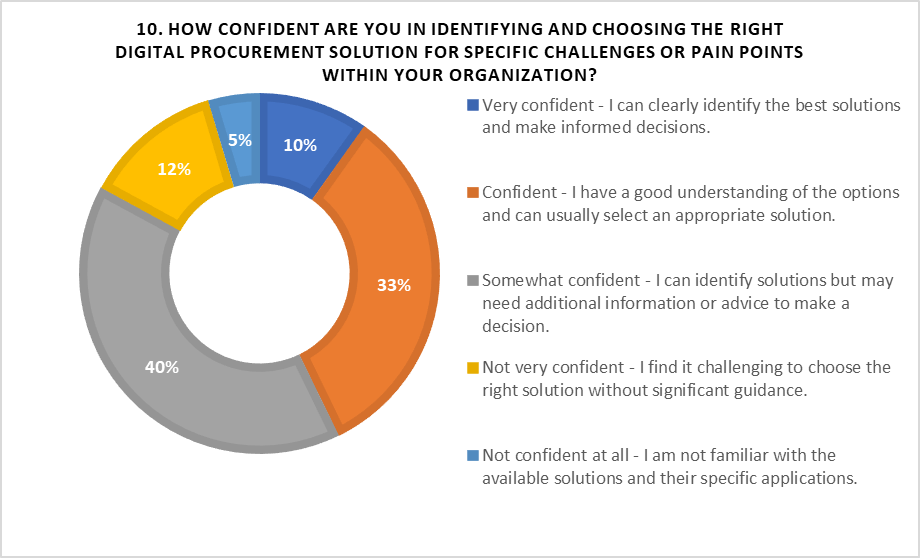
Respondents express varying levels of confidence in identifying and selecting the right digital procurement solution for organizational challenges. While 10% are very confident and 33% express general confidence, a significant portion (40%) feels somewhat confident but may require additional information or advice.
On the other hand, 12% are not very confident, finding it challenging to make decisions without significant guidance, and 5% are not confident at all, indicating a lack of familiarity with available solutions.
Organizations should recognize the need for diverse support mechanisms, providing relevant information and guidance to ensure informed decision-making and maximize the effective utilization of digital procurement solutions.
Select comments from respondents:
“The issue not the identification of the solution, but the real ability to integrate it in the system. It's always a negative surprise”.
“Things are changing so fast you never know whether you will end up buying the betamax”.
Approach to Identifying Use Cases for Solutions
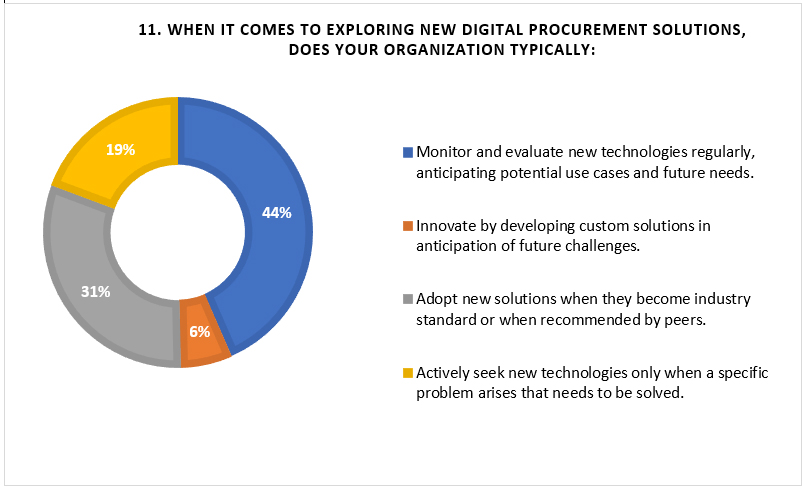
Organizations exhibit diverse approaches to exploring new digital procurement solutions. A majority (44%) proactively monitors and evaluates new technologies regularly, anticipating potential use cases and future needs. A smaller segment (6%) opts for innovation by developing custom solutions in anticipation of future challenges. Meanwhile, 31% prefer adopting new solutions when they become industry standard or are recommended by peers. Lastly, 19% actively seek new technologies only when facing specific problems that need immediate solutions.
The takeaway is that organizations should tailor their strategies to align with their unique operational contexts, leveraging proactive monitoring, innovation, peer recommendations, or targeted problem-solving based on individual needs and goals in the digital procurement landscape.
Select comments from respondents:
“New technologies are demand of the hour and every organization is eager to implement the best one for themselves”.
“This is not optimal. Active use case investigation is a cultural challenge”.
“Usually not until there is a significant pain point identified by our business stakeholder leadership”.
Interest in Exploring New Solutions by Procurement Process
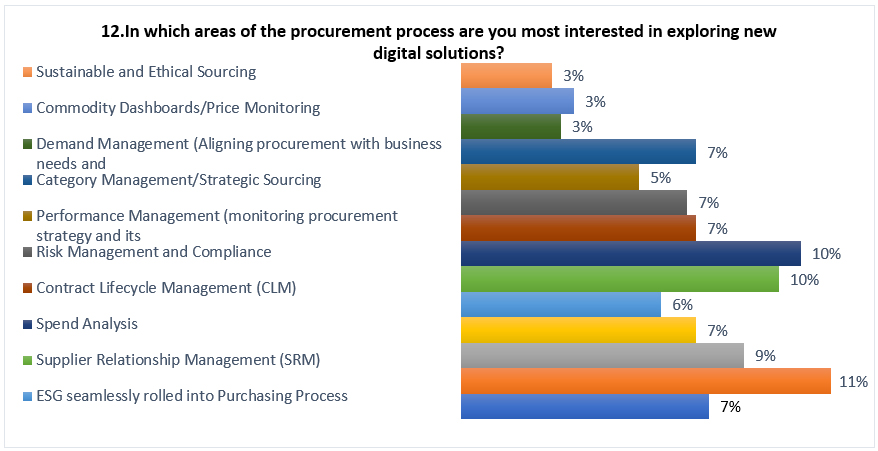
(Multiple selections were allowed)
The survey reveals diverse interests within the procurement community regarding the exploration of new digital solutions.
Notably, AI-enabled Market/Supplier/Commodity Intelligence, Supplier Relationship Management (SRM), and Spend Analysis each garnered the interest of 10% of respondents. AI-driven insights and data-driven decision-making are evidently key areas of focus.
Additionally, Tendering/RFP and Contracting attract 9% and 7%, respectively, showcasing the importance placed on optimizing procurement processes.
ESG integration, Contract Lifecycle Management (CLM), Risk Management and Compliance, and Category Management/Strategic Sourcing each gather interest from 7% of respondents, reflecting a well-rounded consideration of various aspects in the procurement process.
The takeaway is that organizations should recognize these focal points and strategically prioritize digital solutions that align with their specific needs, ensuring a comprehensive and tailored approach to enhance procurement effectiveness.
Select comments from respondents:
- “Just about anything we have tools for. However sometimes you can't beat excel and email”.
- “Detailed Supplier capabilities comparison and filtering”.
- “Especially in the everyday processes of procurement, following up POs and catching up with pending issues on time”.
Embracing Change
The survey paints a dynamic picture of the procurement landscape, where professionals exhibit openness and positivity towards digital transformation, with a firm focus on cost and efficiency. Their moderate to high awareness and proactive stance signal a dedication to embracing change, albeit with acknowledged challenges, particularly in integration.
The survey highlights varying confidence levels in selecting digital solutions, prompting a need for targeted support. Diverse adoption approaches, from proactive monitoring to peer recommendations, underscore the function’s flexibility.
Interests in digital solutions, including cost management and specific procurement processes, reveal nuanced priorities. This multifaceted insight emphasizes the importance of strategic alignment with organizational needs. In navigating this evolving terrain, the survey serves as a valuable compass for stakeholders, guiding effective decision-making, successful technology integration, and continuous enhancement across procurement processes.
Related Insights:
View All
Get more stories like this
Subscirbe for more news,updates and insights from Beroe






